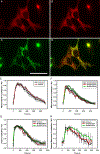Design, construction, and validation of optogenetic proteins
- PMID: 31128778
- PMCID: PMC7003698
- DOI: 10.1016/bs.mie.2019.02.019
Design, construction, and validation of optogenetic proteins
Abstract
Cellular optogenetics employs light-regulated, genetically encoded protein actuators to perturb cellular signaling with unprecedented spatial and temporal control. Here, we present a potentially generalized approach for transforming a given protein of interest (POI) into an optogenetic species. We describe the rational and methods by which we developed three different optogenetic POIs utilizing the Cry2-Cib photodimerizing pair. The process pipeline is highlighted by (1) developing a low level, constitutively active POI that is independent of endogenous regulation, (2) fusion of the mutant protein of interest to an optogenetic photodimerizing system, and (3) light-mediated recruitment of the light-responsive POI to specific subcellular regions.
Keywords: Apoptosis; Biochemical signaling; Motility; Optogenetics; Protein design.
© 2019 Elsevier Inc. All rights reserved.
Figures


Similar articles
-
Following Optogenetic Dimerizers and Quantitative Prospects.Biophys J. 2016 Sep 20;111(6):1132-1140. doi: 10.1016/j.bpj.2016.07.040. Epub 2016 Aug 17. Biophys J. 2016. PMID: 27542508 Free PMC article. Review.
-
Optimized second-generation CRY2-CIB dimerizers and photoactivatable Cre recombinase.Nat Chem Biol. 2016 Jun;12(6):425-30. doi: 10.1038/nchembio.2063. Epub 2016 Apr 11. Nat Chem Biol. 2016. PMID: 27065233 Free PMC article.
-
Advances in optogenetic regulation of gene expression in mammalian cells using cryptochrome 2 (CRY2).Methods. 2019 Jul 15;164-165:81-90. doi: 10.1016/j.ymeth.2019.03.011. Epub 2019 Mar 21. Methods. 2019. PMID: 30905749 Free PMC article.
-
CL6mN: Rationally Designed Optogenetic Photoswitches with Tunable Dissociation Dynamics.ACS Synth Biol. 2020 Sep 18;9(9):2274-2281. doi: 10.1021/acssynbio.0c00362. Epub 2020 Aug 14. ACS Synth Biol. 2020. PMID: 32794731
-
Synergistic Ensemble of Optogenetic Actuators and Dynamic Indicators in Cell Biology.Mol Cells. 2018 Sep 30;41(9):809-817. doi: 10.14348/molcells.2018.0295. Epub 2018 Aug 29. Mol Cells. 2018. PMID: 30157546 Free PMC article. Review.
Cited by
-
Regulation of CAR transgene expression to design semiautonomous CAR-T.Mol Ther Oncol. 2024 Jun 14;32(3):200833. doi: 10.1016/j.omton.2024.200833. eCollection 2024 Sep 19. Mol Ther Oncol. 2024. PMID: 39184876 Free PMC article. Review.
-
Emerging optogenetics technologies in biomedical applications.Smart Med. 2023 Nov 1;2(4):e20230026. doi: 10.1002/SMMD.20230026. eCollection 2023 Nov. Smart Med. 2023. PMID: 39188295 Free PMC article. Review.
References
-
- Gibson RM, & Taylor SS (1997). Dissecting the cooperative reassociation of the regulatory and catalytic subunits of camp-dependent protein kinase. Role of Trp-196 in the catalytic subunit. The Journal of Biological Chemistry, 272(51), 31998–32005. - PubMed
-
- Lichtner RB, Wiedemuth M, Noeske-Jungblut C, & Schirrmacher V (1993). Rapid effects of EGF on cytoskeletal structures and adhesive properties of highly metastatic rat mammary adenocarcinoma cells. Clinical & Experimental Metastasis, 11(1), 113–125. - PubMed
Publication types
MeSH terms
Substances
Grants and funding
LinkOut - more resources
Full Text Sources
Research Materials

